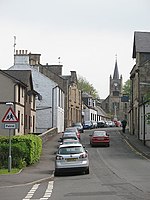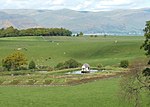Gillies Hill

Gillies Hill is located west of Stirling and the M9, south of Cambusbarron, and north of the Bannock Burn in Central Scotland. Gillies Hill covers a 140 hectares (350 acres) crag and tail which rises from a height of 79 metres (259 ft) at the Bannock Burn Bridge near Sauchie Craig to an elevation of 162 m (531 ft) at a point which overlooks the former quarrying operation to the west and Stirling Castle to the east. The hill lies north of the Bannock Burn, northeast of Sauchie Craig (an area designated SSSI, Site of Special Scientific Interest), east of the Touch Hills and Murrayswood, south of Cambusbarron, and west of Stirling and the M9. Gillies Hill is the hill from which Robert the Bruce’s camp followers, or Gillies, descended onto the field of the Battle of Bannockburn in 1314 turning the tide of the battle which granted Scotland nearly 400 years of independence. The majority of Gillies Hill has been classified as a Semi-natural Ancient Woodland by The Woodland Trust using aerial surveys and by a follow-up Phase 1 habitat survey conducted in 2010. To date 21 Scotland & 38 United Kingdom ancient woodland indicator species have been documented on the hill demonstrating that the woodland's understory and sections of its tree cover have been cloaked in woodland for centuries; the earliest mapped confirmation of trees on the site dates back to the 1580s Pont map.
Excerpt from the Wikipedia article Gillies Hill (License: CC BY-SA 3.0, Authors, Images).Gillies Hill
Gateside Road, Stirling Torbrex
Geographical coordinates (GPS) Address Nearby Places Show on map
Geographical coordinates (GPS)
| Latitude | Longitude |
|---|---|
| N 56.0975 ° | E -3.9758333333333 ° |
Address
Gateside Road
Gateside Road
FK7 9PX Stirling, Torbrex
Scotland, United Kingdom
Open on Google Maps







